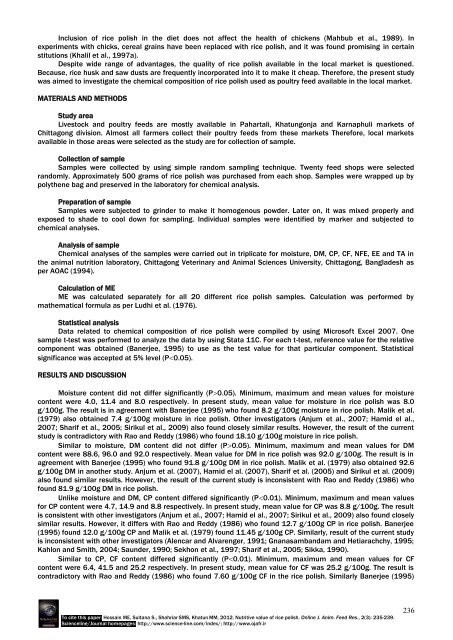NUTRITIVE VALUE OF RICE POLISH - Journal
NUTRITIVE VALUE OF RICE POLISH - Journal
NUTRITIVE VALUE OF RICE POLISH - Journal
You also want an ePaper? Increase the reach of your titles
YUMPU automatically turns print PDFs into web optimized ePapers that Google loves.
Inclusion of rice polish in the diet does not affect the health of chickens (Mahbub et al., 1989). In<br />
experiments with chicks, cereal grains have been replaced with rice polish, and it was found promising in certain<br />
stitutions (Khalil et al., 1997a).<br />
Despite wide range of advantages, the quality of rice polish available in the local market is questioned.<br />
Because, rice husk and saw dusts are frequently incorporated into it to make it cheap. Therefore, the present study<br />
was aimed to investigate the chemical composition of rice polish used as poultry feed available in the local market.<br />
MATERIALS AND METHODS<br />
Study area<br />
Livestock and poultry feeds are mostly available in Pahartali, Khatungonja and Karnaphuli markets of<br />
Chittagong division. Almost all farmers collect their poultry feeds from these markets Therefore, local markets<br />
available in those areas were selected as the study are for collection of sample.<br />
Collection of sample<br />
Samples were collected by using simple random sampling technique. Twenty feed shops were selected<br />
randomly. Approximately 500 grams of rice polish was purchased from each shop. Samples were wrapped up by<br />
polythene bag and preserved in the laboratory for chemical analysis.<br />
Preparation of sample<br />
Samples were subjected to grinder to make it homogenous powder. Later on, it was mixed properly and<br />
exposed to shade to cool down for sampling. Individual samples were identified by marker and subjected to<br />
chemical analyses.<br />
Analysis of sample<br />
Chemical analyses of the samples were carried out in triplicate for moisture, DM, CP, CF, NFE, EE and TA in<br />
the animal nutrition laboratory, Chittagong Veterinary and Animal Sciences University, Chittagong, Bangladesh as<br />
per AOAC (1994).<br />
Calculation of ME<br />
ME was calculated separately for all 20 different rice polish samples. Calculation was performed by<br />
mathematical formula as per Ludhi et al. (1976).<br />
Statistical analysis<br />
Data related to chemical composition of rice polish were compiled by using Microsoft Excel 2007. One<br />
sample t-test was performed to analyze the data by using Stata 11C. For each t-test, reference value for the relative<br />
component was obtained (Banerjee, 1995) to use as the test value for that particular component. Statistical<br />
significance was accepted at 5% level (P�0.05).<br />
RESULTS AND DISCUSSION<br />
Moisture content did not differ significantly (P�0.05). Minimum, maximum and mean values for moisture<br />
content were 4.0, 11.4 and 8.0 respectively. In present study, mean value for moisture in rice polish was 8.0<br />
g/100g. The result is in agreement with Banerjee (1995) who found 8.2 g/100g moisture in rice polish. Malik et al.<br />
(1979) also obtained 7.4 g/100g moisture in rice polish. Other investigators (Anjum et al., 2007; Hamid el al.,<br />
2007; Sharif et al., 2005; Sirikul et al., 2009) also found closely similar results. However, the result of the current<br />
study is contradictory with Rao and Reddy (1986) who found 18.10 g/100g moisture in rice polish.<br />
Similar to moisture, DM content did not differ (P�0.05). Minimum, maximum and mean values for DM<br />
content were 88.6, 96.0 and 92.0 respectively. Mean value for DM in rice polish was 92.0 g/100g. The result is in<br />
agreement with Banerjee (1995) who found 91.8 g/100g DM in rice polish. Malik et al. (1979) also obtained 92.6<br />
g/100g DM in another study. Anjum et al. (2007), Hamid el al. (2007), Sharif et al. (2005) and Sirikul et al. (2009)<br />
also found similar results. However, the result of the current study is inconsistent with Rao and Reddy (1986) who<br />
found 81.9 g/100g DM in rice polish.<br />
Unlike moisture and DM, CP content differed significantly (P�0.01). Minimum, maximum and mean values<br />
for CP content were 4.7, 14.9 and 8.8 respectively. In present study, mean value for CP was 8.8 g/100g. The result<br />
is consistent with other investigators (Anjum et al., 2007; Hamid el al., 2007; Sirikul et al., 2009) also found closely<br />
similar results. However, it differs with Rao and Reddy (1986) who found 12.7 g/100g CP in rice polish. Banerjee<br />
(1995) found 12.0 g/100g CP and Malik et al. (1979) found 11.45 g/100g CP. Similarly, result of the current study<br />
is inconsistent with other investigators (Alencar and Alvarenger, 1991; Gnanasambandam and Hetiarachchy, 1995;<br />
Kahlon and Smith, 2004; Saunder, 1990; Sekhon et al., 1997; Sharif et al., 2005; Sikka, 1990).<br />
Similar to CP, CF content differed significantly (P�0.01). Minimum, maximum and mean values for CF<br />
content were 6.4, 41.5 and 25.2 respectively. In present study, mean value for CF was 25.2 g/100g. The result is<br />
contradictory with Rao and Reddy (1986) who found 7.60 g/100g CF in the rice polish. Similarly Banerjee (1995)<br />
To cite this paper: Hossain ME, Sultana S., Shahriar SMS, Khatun MM, 2012. Nutritive value of rice polish. Online J. Anim. Feed Res., 2(3): 235-239.<br />
Scienceline/<strong>Journal</strong> homepages: http://www.science-line.com/index/; http://www.ojafr.ir<br />
236



